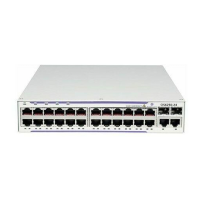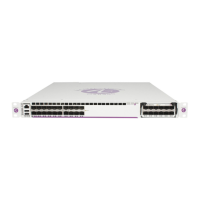QoS Overview
Page 68 7210 SAS D, E, K OS Quality of Service Guide
Simplified overview of RED for 7210 SAS-D
The following is a simplified overview of how a RED slope determines shared buffer availability
on a packet basis:
1. The RED function keeps track of shared buffer utilization and shared buffer average utiliza-
tion.
2. At initialization, the utilization is 0 (zero) and the average utilization is 0 (zero).
3. When each packet is received, the current average utilization is plotted on the slope to deter-
mine the packet’s discard probability.
4. A random number is generated associated with the packet and is compared to the discard
probability.
5. The lower the discard probability, the lower the chances are that the random number is within
the discard range.
6. If the random number is within the range, the packet is discarded which results in no change
to the utilization or average utilization of the shared buffers.
7. A packet is discarded if the utilization variable is equal to the shared buffer size or if the uti-
lized CBS (actually in use by queues, not just defined by the CBS) is oversubscribed and has
stolen buffers from the shared size, lowering the effective shared buffer size equal to the
shared buffer utilization size.
8. If the packet is queued, a new shared buffer average utilization is calculated using the time
average-factor (TAF) for the buffer pool. The TAF describes the weighting between the pre-
vious shared buffer average utilization result and the new shared buffer utilization in deter-
mining the new shared buffer average utilization. (See Tuning the Shared Buffer Utilization
Calculation on page 76.)
9. The new shared buffer average utilization is used as the shared buffer average utilization next
time a packet’s probability is plotted on the RED slope.
10.When a packet is removed from a queue (if the buffers returned to the buffer pool are from
the shared buffers), the shared buffer utilization is reduced by the amount of buffers returned.
If the buffers are from the CBS portion of the queue, the returned buffers do not result in a
change in the shared buffer utilization.

